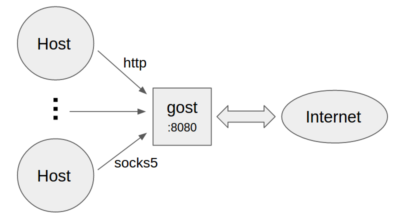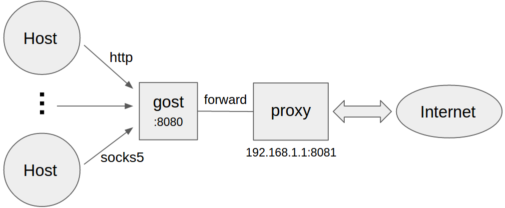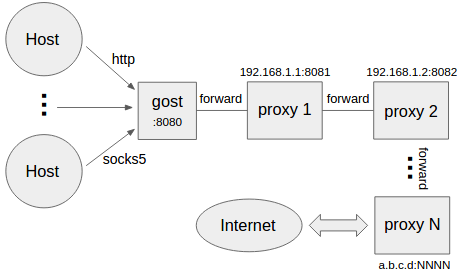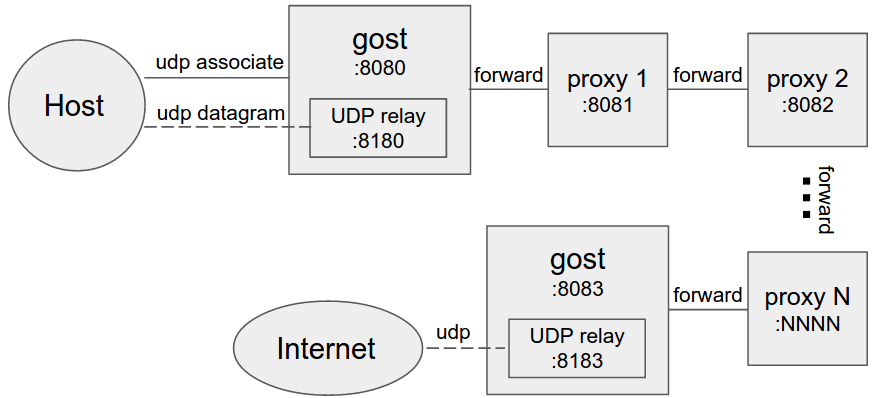gost - GO Simple Tunnel
======
### A simple security tunnel written in Golang
Features
------
* Listening on multiple ports
* Multi-level forward proxy - proxy chain
* Standard HTTP/HTTPS/SOCKS5 proxy protocols support
* TLS encryption via negotiation support for SOCKS5 proxy
* Tunnel UDP over TCP
* Shadowsocks protocol support with OTA option (OTA: >=2.2)
* Local/remote port forwarding (>=2.1)
* HTTP2.0 (>=2.2)
* Experimental QUIC support (>=2.3)
* KCP (>=2.3)
Binary file download:https://github.com/ginuerzh/gost/releases
Google group: https://groups.google.com/d/forum/go-gost
Gost and other proxy services are considered to be proxy nodes,
gost can handle the request itself, or forward the request to any one or more proxy nodes.
Parameter Description
------
#### Proxy and proxy chain
Effective for the -L and -F parameters
```bash
[scheme://][user:pass@host]:port
```
scheme can be divided into two parts: protocol+transport
protocol: proxy protocol types (http, socks5, shadowsocks),
transport: data transmission mode (ws, wss, tls, http2, quic, kcp), may be used in any combination or individually:
> http - standard HTTP proxy: http://:8080
> http+tls - standard HTTPS proxy (may need to provide a trusted certificate): http+tls://:443
> http2 - HTTP2 proxy and backwards-compatible with HTTPS proxy: http2://:443
> socks - standard SOCKS5 proxy: socks://:1080
> socks+wss - SOCKS5 over websocket: socks+wss://:1080
> tls - HTTPS/SOCKS5 over tls: tls://:443
> ss - standard shadowsocks proxy, ss://aes-256-cfb:123456@:8338
> quic - standard QUIC proxy, quic://:6121
> kcp - standard KCP tunnel,kcp://:8388
#### Port forwarding
Effective for the -L parameter
```bash
scheme://[bind_address]:port/[host]:hostport
```
> scheme - forward mode, local: tcp, udp; remote: rtcp, rudp
> bind_address:port - local/remote binding address
> host:hostport - target address
#### Logging
> -logtostderr : log to console
> -v=3 : log level (1-5),The higher the level, the more detailed the log (level 5 will enable HTTP2 debug)
> -log_dir=/log/dir/path : log to directory /log/dir/path
Usage
------
#### No forward proxy
 * Standard HTTP/SOCKS5 proxy
```bash
gost -L=:8080
```
* Proxy authentication
```bash
gost -L=admin:123456@localhost:8080
```
* Listen on multiple ports
```bash
gost -L=http2://:443 -L=socks://:1080 -L=ss://aes-128-cfb:123456@:8338
```
#### Forward proxy
* Standard HTTP/SOCKS5 proxy
```bash
gost -L=:8080
```
* Proxy authentication
```bash
gost -L=admin:123456@localhost:8080
```
* Listen on multiple ports
```bash
gost -L=http2://:443 -L=socks://:1080 -L=ss://aes-128-cfb:123456@:8338
```
#### Forward proxy
 ```bash
gost -L=:8080 -F=192.168.1.1:8081
```
* Forward proxy authentication
```bash
gost -L=:8080 -F=http://admin:123456@192.168.1.1:8081
```
#### Multi-level forward proxy
```bash
gost -L=:8080 -F=192.168.1.1:8081
```
* Forward proxy authentication
```bash
gost -L=:8080 -F=http://admin:123456@192.168.1.1:8081
```
#### Multi-level forward proxy
 ```bash
gost -L=:8080 -F=http+tls://192.168.1.1:443 -F=socks+ws://192.168.1.2:1080 -F=ss://aes-128-cfb:123456@192.168.1.3:8338 -F=a.b.c.d:NNNN
```
Gost forwards the request to a.b.c.d:NNNN through the proxy chain in the order set by -F,
each forward proxy can be any HTTP/HTTPS/HTTP2/SOCKS5/Shadowsocks type.
#### Local TCP port forwarding
```bash
gost -L=tcp://:2222/192.168.1.1:22 -F=...
```
The data on the local TCP port 2222 is forwarded to 192.168.1.1:22 (through the proxy chain).
#### Local UDP port forwarding
```bash
gost -L=udp://:5353/192.168.1.1:53 -F=...
```
The data on the local UDP port 5353 is forwarded to 192.168.1.1:53 (through the proxy chain).
**NOTE:** When forwarding UDP data, if there is a proxy chain, the end of the chain (the last -F parameter) must be gost SOCKS5 proxy.
#### Remote TCP port forwarding
```bash
gost -L=rtcp://:2222/192.168.1.1:22 -F=... -F=socks://172.24.10.1:1080
```
The data on 172.24.10.1:2222 is forwarded to 192.168.1.1:22 (through the proxy chain).
#### Remote UDP port forwarding
```bash
gost -L=rudp://:5353/192.168.1.1:53 -F=... -F=socks://172.24.10.1:1080
```
The data on 172.24.10.1:5353 is forwarded to 192.168.1.1:53 (through the proxy chain).
**NOTE:** To use the remote port forwarding feature, the proxy chain can not be empty (at least one -F parameter is set)
and the end of the chain (last -F parameter) must be gost SOCKS5 proxy.
#### HTTP2
Gost HTTP2 supports two modes and self-adapting:
* As a standard HTTP2 proxy, and backwards-compatible with the HTTPS proxy.
* As transport (similar to wss), tunnel other protocol.
**NOTE:** The proxy chain of gost supports only one HTTP2 proxy node and the nearest rule applies,
the first HTTP2 proxy node is treated as an HTTP2 proxy, and the other HTTP2 proxy nodes are treated as HTTPS proxies.
#### QUIC
Support for QUIC is based on library [quic-go](https://github.com/lucas-clemente/quic-go).
Server:
```bash
gost -L=quic://:6121
```
Client(Chrome):
```bash
chrome --enable-quic --proxy-server=quic://server_ip:6121
```
**NOTE:** Due to Chrome's limitations, it is currently only possible to access the HTTP (but not HTTPS) site through QUIC.
#### KCP
Support for KCP is based on libraries [kcp-go](https://github.com/xtaci/kcp-go) and [kcptun](https://github.com/xtaci/kcptun).
Server:
```bash
gost -L=kcp://:8388
```
Client:
```bash
gost -L=:8080 -F=kcp://server_ip:8388
```
**NOTE:** KCP will be enabled if and only if the proxy chain is not empty and the first proxy node (the first -F parameter) is of type KCP.
When KCP is enabled, other proxy nodes are ignored.
Encryption Mechanism
------
#### HTTP
For HTTP, you can use TLS to encrypt the entire communication process, the HTTPS proxy:
Server:
```bash
gost -L=http+tls://:443
```
Client:
```bash
gost -L=:8080 -F=http+tls://server_ip:443
```
#### HTTP2
Gost supports only the HTTP2 protocol that uses TLS encryption (h2) and does not support plaintext HTTP2 (h2c) transport.
Server:
```bash
gost -L=http2://:443
```
Client:
```bash
gost -L=:8080 -F=http2://server_ip:443
```
#### SOCKS5
Gost supports the standard SOCKS5 protocol methods: no-auth (0x00) and user/pass (0x02),
and extends two methods for data encryption: tls(0x80) and tls-auth(0x82).
Server:
```bash
gost -L=socks://:1080
```
Client:
```bash
gost -L=:8080 -F=socks://server_ip:1080
```
If both ends are gosts (as example above), the data transfer will be encrypted (using tls or tls-auth).
Otherwise, use standard SOCKS5 for communication (no-auth or user/pass).
**NOTE:** If transport already supports encryption (wss, tls, http2), SOCKS5 will no longer use the encryption method to prevent unnecessary double encryption.
#### Shadowsocks
Support for shadowsocks is based on library [shadowsocks-go](https://github.com/shadowsocks/shadowsocks-go).
Server (The OTA mode can be enabled by the ota parameter):
```bash
gost -L=ss://aes-128-cfb:123456@:8338?ota=1
```
Client:
```bash
gost -L=:8080 -F=ss://aes-128-cfb:123456@server_ip:8338
```
#### TLS
There is built-in TLS certificate in gost, if you need to use other TLS certificate, there are two ways:
* Place two files cert.pem (public key) and key.pem (private key) in the current working directory, gost will automatically load them.
* Use the parameter to specify the path to the certificate file:
```bash
gost -L="http2://:443?cert=/path/to/my/cert/file&key=/path/to/my/key/file"
```
SOCKS5 UDP Data Processing
------
#### No forward proxy
```bash
gost -L=:8080 -F=http+tls://192.168.1.1:443 -F=socks+ws://192.168.1.2:1080 -F=ss://aes-128-cfb:123456@192.168.1.3:8338 -F=a.b.c.d:NNNN
```
Gost forwards the request to a.b.c.d:NNNN through the proxy chain in the order set by -F,
each forward proxy can be any HTTP/HTTPS/HTTP2/SOCKS5/Shadowsocks type.
#### Local TCP port forwarding
```bash
gost -L=tcp://:2222/192.168.1.1:22 -F=...
```
The data on the local TCP port 2222 is forwarded to 192.168.1.1:22 (through the proxy chain).
#### Local UDP port forwarding
```bash
gost -L=udp://:5353/192.168.1.1:53 -F=...
```
The data on the local UDP port 5353 is forwarded to 192.168.1.1:53 (through the proxy chain).
**NOTE:** When forwarding UDP data, if there is a proxy chain, the end of the chain (the last -F parameter) must be gost SOCKS5 proxy.
#### Remote TCP port forwarding
```bash
gost -L=rtcp://:2222/192.168.1.1:22 -F=... -F=socks://172.24.10.1:1080
```
The data on 172.24.10.1:2222 is forwarded to 192.168.1.1:22 (through the proxy chain).
#### Remote UDP port forwarding
```bash
gost -L=rudp://:5353/192.168.1.1:53 -F=... -F=socks://172.24.10.1:1080
```
The data on 172.24.10.1:5353 is forwarded to 192.168.1.1:53 (through the proxy chain).
**NOTE:** To use the remote port forwarding feature, the proxy chain can not be empty (at least one -F parameter is set)
and the end of the chain (last -F parameter) must be gost SOCKS5 proxy.
#### HTTP2
Gost HTTP2 supports two modes and self-adapting:
* As a standard HTTP2 proxy, and backwards-compatible with the HTTPS proxy.
* As transport (similar to wss), tunnel other protocol.
**NOTE:** The proxy chain of gost supports only one HTTP2 proxy node and the nearest rule applies,
the first HTTP2 proxy node is treated as an HTTP2 proxy, and the other HTTP2 proxy nodes are treated as HTTPS proxies.
#### QUIC
Support for QUIC is based on library [quic-go](https://github.com/lucas-clemente/quic-go).
Server:
```bash
gost -L=quic://:6121
```
Client(Chrome):
```bash
chrome --enable-quic --proxy-server=quic://server_ip:6121
```
**NOTE:** Due to Chrome's limitations, it is currently only possible to access the HTTP (but not HTTPS) site through QUIC.
#### KCP
Support for KCP is based on libraries [kcp-go](https://github.com/xtaci/kcp-go) and [kcptun](https://github.com/xtaci/kcptun).
Server:
```bash
gost -L=kcp://:8388
```
Client:
```bash
gost -L=:8080 -F=kcp://server_ip:8388
```
**NOTE:** KCP will be enabled if and only if the proxy chain is not empty and the first proxy node (the first -F parameter) is of type KCP.
When KCP is enabled, other proxy nodes are ignored.
Encryption Mechanism
------
#### HTTP
For HTTP, you can use TLS to encrypt the entire communication process, the HTTPS proxy:
Server:
```bash
gost -L=http+tls://:443
```
Client:
```bash
gost -L=:8080 -F=http+tls://server_ip:443
```
#### HTTP2
Gost supports only the HTTP2 protocol that uses TLS encryption (h2) and does not support plaintext HTTP2 (h2c) transport.
Server:
```bash
gost -L=http2://:443
```
Client:
```bash
gost -L=:8080 -F=http2://server_ip:443
```
#### SOCKS5
Gost supports the standard SOCKS5 protocol methods: no-auth (0x00) and user/pass (0x02),
and extends two methods for data encryption: tls(0x80) and tls-auth(0x82).
Server:
```bash
gost -L=socks://:1080
```
Client:
```bash
gost -L=:8080 -F=socks://server_ip:1080
```
If both ends are gosts (as example above), the data transfer will be encrypted (using tls or tls-auth).
Otherwise, use standard SOCKS5 for communication (no-auth or user/pass).
**NOTE:** If transport already supports encryption (wss, tls, http2), SOCKS5 will no longer use the encryption method to prevent unnecessary double encryption.
#### Shadowsocks
Support for shadowsocks is based on library [shadowsocks-go](https://github.com/shadowsocks/shadowsocks-go).
Server (The OTA mode can be enabled by the ota parameter):
```bash
gost -L=ss://aes-128-cfb:123456@:8338?ota=1
```
Client:
```bash
gost -L=:8080 -F=ss://aes-128-cfb:123456@server_ip:8338
```
#### TLS
There is built-in TLS certificate in gost, if you need to use other TLS certificate, there are two ways:
* Place two files cert.pem (public key) and key.pem (private key) in the current working directory, gost will automatically load them.
* Use the parameter to specify the path to the certificate file:
```bash
gost -L="http2://:443?cert=/path/to/my/cert/file&key=/path/to/my/key/file"
```
SOCKS5 UDP Data Processing
------
#### No forward proxy
 Gost acts as the standard SOCKS5 proxy for UDP relay.
#### Forward proxy
Gost acts as the standard SOCKS5 proxy for UDP relay.
#### Forward proxy
 #### Multi-level forward proxy
#### Multi-level forward proxy
 When forward proxies are set, gost uses UDP-over-TCP to forward UDP data, proxy1 to proxyN can be any HTTP/HTTPS/HTTP2/SOCKS5/Shadowsocks type.
Limitation
------
The HTTP proxy node in the proxy chain must support the CONNECT method.
If the BIND and UDP requests for SOCKS5 are to be forwarded, the end of the chain (the last -F parameter) must be the gost SOCKS5 proxy.
When forward proxies are set, gost uses UDP-over-TCP to forward UDP data, proxy1 to proxyN can be any HTTP/HTTPS/HTTP2/SOCKS5/Shadowsocks type.
Limitation
------
The HTTP proxy node in the proxy chain must support the CONNECT method.
If the BIND and UDP requests for SOCKS5 are to be forwarded, the end of the chain (the last -F parameter) must be the gost SOCKS5 proxy.
 * Standard HTTP/SOCKS5 proxy
```bash
gost -L=:8080
```
* Proxy authentication
```bash
gost -L=admin:123456@localhost:8080
```
* Listen on multiple ports
```bash
gost -L=http2://:443 -L=socks://:1080 -L=ss://aes-128-cfb:123456@:8338
```
#### Forward proxy
* Standard HTTP/SOCKS5 proxy
```bash
gost -L=:8080
```
* Proxy authentication
```bash
gost -L=admin:123456@localhost:8080
```
* Listen on multiple ports
```bash
gost -L=http2://:443 -L=socks://:1080 -L=ss://aes-128-cfb:123456@:8338
```
#### Forward proxy
 ```bash
gost -L=:8080 -F=192.168.1.1:8081
```
* Forward proxy authentication
```bash
gost -L=:8080 -F=http://admin:123456@192.168.1.1:8081
```
#### Multi-level forward proxy
```bash
gost -L=:8080 -F=192.168.1.1:8081
```
* Forward proxy authentication
```bash
gost -L=:8080 -F=http://admin:123456@192.168.1.1:8081
```
#### Multi-level forward proxy
 ```bash
gost -L=:8080 -F=http+tls://192.168.1.1:443 -F=socks+ws://192.168.1.2:1080 -F=ss://aes-128-cfb:123456@192.168.1.3:8338 -F=a.b.c.d:NNNN
```
Gost forwards the request to a.b.c.d:NNNN through the proxy chain in the order set by -F,
each forward proxy can be any HTTP/HTTPS/HTTP2/SOCKS5/Shadowsocks type.
#### Local TCP port forwarding
```bash
gost -L=tcp://:2222/192.168.1.1:22 -F=...
```
The data on the local TCP port 2222 is forwarded to 192.168.1.1:22 (through the proxy chain).
#### Local UDP port forwarding
```bash
gost -L=udp://:5353/192.168.1.1:53 -F=...
```
The data on the local UDP port 5353 is forwarded to 192.168.1.1:53 (through the proxy chain).
**NOTE:** When forwarding UDP data, if there is a proxy chain, the end of the chain (the last -F parameter) must be gost SOCKS5 proxy.
#### Remote TCP port forwarding
```bash
gost -L=rtcp://:2222/192.168.1.1:22 -F=... -F=socks://172.24.10.1:1080
```
The data on 172.24.10.1:2222 is forwarded to 192.168.1.1:22 (through the proxy chain).
#### Remote UDP port forwarding
```bash
gost -L=rudp://:5353/192.168.1.1:53 -F=... -F=socks://172.24.10.1:1080
```
The data on 172.24.10.1:5353 is forwarded to 192.168.1.1:53 (through the proxy chain).
**NOTE:** To use the remote port forwarding feature, the proxy chain can not be empty (at least one -F parameter is set)
and the end of the chain (last -F parameter) must be gost SOCKS5 proxy.
#### HTTP2
Gost HTTP2 supports two modes and self-adapting:
* As a standard HTTP2 proxy, and backwards-compatible with the HTTPS proxy.
* As transport (similar to wss), tunnel other protocol.
**NOTE:** The proxy chain of gost supports only one HTTP2 proxy node and the nearest rule applies,
the first HTTP2 proxy node is treated as an HTTP2 proxy, and the other HTTP2 proxy nodes are treated as HTTPS proxies.
#### QUIC
Support for QUIC is based on library [quic-go](https://github.com/lucas-clemente/quic-go).
Server:
```bash
gost -L=quic://:6121
```
Client(Chrome):
```bash
chrome --enable-quic --proxy-server=quic://server_ip:6121
```
**NOTE:** Due to Chrome's limitations, it is currently only possible to access the HTTP (but not HTTPS) site through QUIC.
#### KCP
Support for KCP is based on libraries [kcp-go](https://github.com/xtaci/kcp-go) and [kcptun](https://github.com/xtaci/kcptun).
Server:
```bash
gost -L=kcp://:8388
```
Client:
```bash
gost -L=:8080 -F=kcp://server_ip:8388
```
**NOTE:** KCP will be enabled if and only if the proxy chain is not empty and the first proxy node (the first -F parameter) is of type KCP.
When KCP is enabled, other proxy nodes are ignored.
Encryption Mechanism
------
#### HTTP
For HTTP, you can use TLS to encrypt the entire communication process, the HTTPS proxy:
Server:
```bash
gost -L=http+tls://:443
```
Client:
```bash
gost -L=:8080 -F=http+tls://server_ip:443
```
#### HTTP2
Gost supports only the HTTP2 protocol that uses TLS encryption (h2) and does not support plaintext HTTP2 (h2c) transport.
Server:
```bash
gost -L=http2://:443
```
Client:
```bash
gost -L=:8080 -F=http2://server_ip:443
```
#### SOCKS5
Gost supports the standard SOCKS5 protocol methods: no-auth (0x00) and user/pass (0x02),
and extends two methods for data encryption: tls(0x80) and tls-auth(0x82).
Server:
```bash
gost -L=socks://:1080
```
Client:
```bash
gost -L=:8080 -F=socks://server_ip:1080
```
If both ends are gosts (as example above), the data transfer will be encrypted (using tls or tls-auth).
Otherwise, use standard SOCKS5 for communication (no-auth or user/pass).
**NOTE:** If transport already supports encryption (wss, tls, http2), SOCKS5 will no longer use the encryption method to prevent unnecessary double encryption.
#### Shadowsocks
Support for shadowsocks is based on library [shadowsocks-go](https://github.com/shadowsocks/shadowsocks-go).
Server (The OTA mode can be enabled by the ota parameter):
```bash
gost -L=ss://aes-128-cfb:123456@:8338?ota=1
```
Client:
```bash
gost -L=:8080 -F=ss://aes-128-cfb:123456@server_ip:8338
```
#### TLS
There is built-in TLS certificate in gost, if you need to use other TLS certificate, there are two ways:
* Place two files cert.pem (public key) and key.pem (private key) in the current working directory, gost will automatically load them.
* Use the parameter to specify the path to the certificate file:
```bash
gost -L="http2://:443?cert=/path/to/my/cert/file&key=/path/to/my/key/file"
```
SOCKS5 UDP Data Processing
------
#### No forward proxy
```bash
gost -L=:8080 -F=http+tls://192.168.1.1:443 -F=socks+ws://192.168.1.2:1080 -F=ss://aes-128-cfb:123456@192.168.1.3:8338 -F=a.b.c.d:NNNN
```
Gost forwards the request to a.b.c.d:NNNN through the proxy chain in the order set by -F,
each forward proxy can be any HTTP/HTTPS/HTTP2/SOCKS5/Shadowsocks type.
#### Local TCP port forwarding
```bash
gost -L=tcp://:2222/192.168.1.1:22 -F=...
```
The data on the local TCP port 2222 is forwarded to 192.168.1.1:22 (through the proxy chain).
#### Local UDP port forwarding
```bash
gost -L=udp://:5353/192.168.1.1:53 -F=...
```
The data on the local UDP port 5353 is forwarded to 192.168.1.1:53 (through the proxy chain).
**NOTE:** When forwarding UDP data, if there is a proxy chain, the end of the chain (the last -F parameter) must be gost SOCKS5 proxy.
#### Remote TCP port forwarding
```bash
gost -L=rtcp://:2222/192.168.1.1:22 -F=... -F=socks://172.24.10.1:1080
```
The data on 172.24.10.1:2222 is forwarded to 192.168.1.1:22 (through the proxy chain).
#### Remote UDP port forwarding
```bash
gost -L=rudp://:5353/192.168.1.1:53 -F=... -F=socks://172.24.10.1:1080
```
The data on 172.24.10.1:5353 is forwarded to 192.168.1.1:53 (through the proxy chain).
**NOTE:** To use the remote port forwarding feature, the proxy chain can not be empty (at least one -F parameter is set)
and the end of the chain (last -F parameter) must be gost SOCKS5 proxy.
#### HTTP2
Gost HTTP2 supports two modes and self-adapting:
* As a standard HTTP2 proxy, and backwards-compatible with the HTTPS proxy.
* As transport (similar to wss), tunnel other protocol.
**NOTE:** The proxy chain of gost supports only one HTTP2 proxy node and the nearest rule applies,
the first HTTP2 proxy node is treated as an HTTP2 proxy, and the other HTTP2 proxy nodes are treated as HTTPS proxies.
#### QUIC
Support for QUIC is based on library [quic-go](https://github.com/lucas-clemente/quic-go).
Server:
```bash
gost -L=quic://:6121
```
Client(Chrome):
```bash
chrome --enable-quic --proxy-server=quic://server_ip:6121
```
**NOTE:** Due to Chrome's limitations, it is currently only possible to access the HTTP (but not HTTPS) site through QUIC.
#### KCP
Support for KCP is based on libraries [kcp-go](https://github.com/xtaci/kcp-go) and [kcptun](https://github.com/xtaci/kcptun).
Server:
```bash
gost -L=kcp://:8388
```
Client:
```bash
gost -L=:8080 -F=kcp://server_ip:8388
```
**NOTE:** KCP will be enabled if and only if the proxy chain is not empty and the first proxy node (the first -F parameter) is of type KCP.
When KCP is enabled, other proxy nodes are ignored.
Encryption Mechanism
------
#### HTTP
For HTTP, you can use TLS to encrypt the entire communication process, the HTTPS proxy:
Server:
```bash
gost -L=http+tls://:443
```
Client:
```bash
gost -L=:8080 -F=http+tls://server_ip:443
```
#### HTTP2
Gost supports only the HTTP2 protocol that uses TLS encryption (h2) and does not support plaintext HTTP2 (h2c) transport.
Server:
```bash
gost -L=http2://:443
```
Client:
```bash
gost -L=:8080 -F=http2://server_ip:443
```
#### SOCKS5
Gost supports the standard SOCKS5 protocol methods: no-auth (0x00) and user/pass (0x02),
and extends two methods for data encryption: tls(0x80) and tls-auth(0x82).
Server:
```bash
gost -L=socks://:1080
```
Client:
```bash
gost -L=:8080 -F=socks://server_ip:1080
```
If both ends are gosts (as example above), the data transfer will be encrypted (using tls or tls-auth).
Otherwise, use standard SOCKS5 for communication (no-auth or user/pass).
**NOTE:** If transport already supports encryption (wss, tls, http2), SOCKS5 will no longer use the encryption method to prevent unnecessary double encryption.
#### Shadowsocks
Support for shadowsocks is based on library [shadowsocks-go](https://github.com/shadowsocks/shadowsocks-go).
Server (The OTA mode can be enabled by the ota parameter):
```bash
gost -L=ss://aes-128-cfb:123456@:8338?ota=1
```
Client:
```bash
gost -L=:8080 -F=ss://aes-128-cfb:123456@server_ip:8338
```
#### TLS
There is built-in TLS certificate in gost, if you need to use other TLS certificate, there are two ways:
* Place two files cert.pem (public key) and key.pem (private key) in the current working directory, gost will automatically load them.
* Use the parameter to specify the path to the certificate file:
```bash
gost -L="http2://:443?cert=/path/to/my/cert/file&key=/path/to/my/key/file"
```
SOCKS5 UDP Data Processing
------
#### No forward proxy
 Gost acts as the standard SOCKS5 proxy for UDP relay.
#### Forward proxy
Gost acts as the standard SOCKS5 proxy for UDP relay.
#### Forward proxy
 #### Multi-level forward proxy
#### Multi-level forward proxy
 When forward proxies are set, gost uses UDP-over-TCP to forward UDP data, proxy1 to proxyN can be any HTTP/HTTPS/HTTP2/SOCKS5/Shadowsocks type.
Limitation
------
The HTTP proxy node in the proxy chain must support the CONNECT method.
If the BIND and UDP requests for SOCKS5 are to be forwarded, the end of the chain (the last -F parameter) must be the gost SOCKS5 proxy.
When forward proxies are set, gost uses UDP-over-TCP to forward UDP data, proxy1 to proxyN can be any HTTP/HTTPS/HTTP2/SOCKS5/Shadowsocks type.
Limitation
------
The HTTP proxy node in the proxy chain must support the CONNECT method.
If the BIND and UDP requests for SOCKS5 are to be forwarded, the end of the chain (the last -F parameter) must be the gost SOCKS5 proxy.